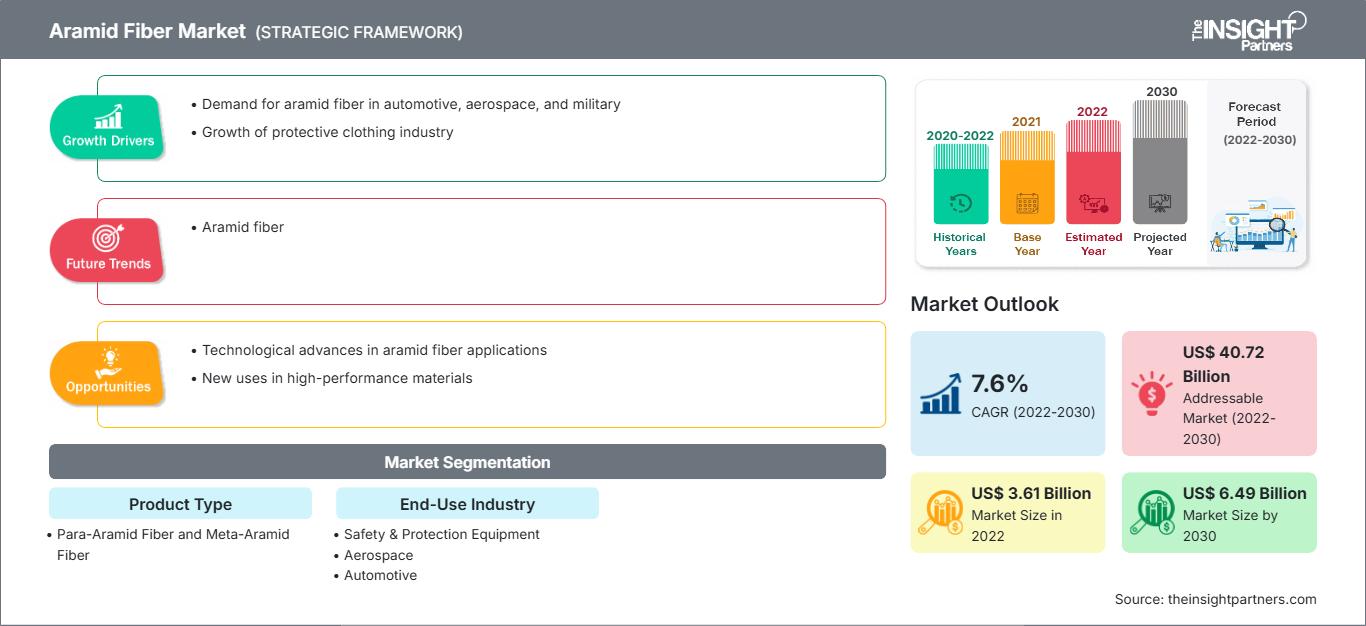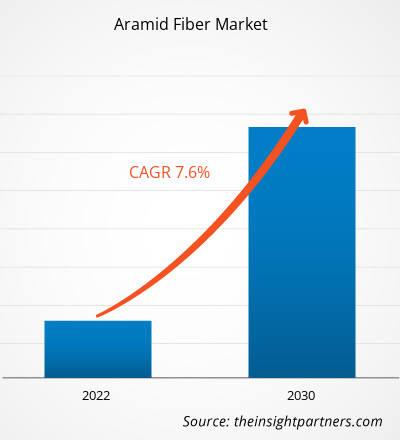[研究报告] 2022 年芳纶纤维市场规模为 36.1 亿美元,预计到 2030 年将达到 64.9 亿美元;预计 2022 年至 2030 年的复合年增长率为 7.6%。
市场洞察和分析师观点:
芳纶纤维,也称为芳香族聚酰胺,是一种具有优异强度、耐热性和耐用性的合成纤维。它们以其高抗拉强度而闻名,抗拉强度是钢的五到六倍,而且重量轻,仅为钢的五分之一。这些卓越的性能使这些纤维具有广泛的应用价值,特别是在对性能和安全性要求高的行业中。芳纶纤维的独特结构对其优异的性能贡献巨大。这些纤维由长链聚酰胺分子组成,其中酰胺键直接与芳香环相连。这种排列形成了坚硬的棒状结构,赋予纤维卓越的强度和刚度。此外,芳环赋予了纤维固有的耐热性和稳定性,使这些纤维能够承受高温而不会发生显著降解。
增长动力与挑战:
汽车行业日益增长的需求一直是芳纶纤维市场扩张的主要驱动力。随着汽车制造商越来越注重生产更轻、更省油的汽车,对这些纤维的需求呈指数级增长。这些纤维,尤其是包括凯夫拉在内的对位芳纶变体,具有较高的强度重量比,使得在不影响结构完整性的情况下开发轻量化部件成为可能。在汽车领域,这些纤维广泛应用于各种应用,包括制造轮胎、刹车片、衬垫和复合材料。用这些纤维加固这些部件可以提高其耐用性和耐磨性,从而延长使用寿命并提高整体性能。此外,这些纤维还用于生产汽车复合材料,在强度和重量之间取得平衡,这对于实现燃油效率目标至关重要。因此,所有这些因素都在推动汽车行业对芳纶纤维的需求。
然而,芳纶纤维市场的增长受限于具有类似或替代性能的替代品的供应。碳纤维是这些纤维的主要替代品之一,它与芳纶纤维具有一些共同的特性,包括高强度和轻质。在某些应用中,制造商可能会选择碳纤维作为替代品,尤其是在寻求具有优异刚度或导电性的材料时。来自替代品的竞争对这些纤维的广泛应用构成了挑战,尤其是在两种材料都可能满足所需规格的行业中。
自定义此报告以满足您的要求
您将免费获得任何报告的定制,包括本报告的部分内容,或国家级分析、Excel 数据包,以及为初创企业和大学提供超值优惠和折扣
芳纶纤维市场: 战略洞察

- 获取本报告的主要市场趋势。这个免费样本将包括数据分析,从市场趋势到估计和预测。
您将免费获得任何报告的定制,包括本报告的部分内容,或国家级分析、Excel 数据包,以及为初创企业和大学提供超值优惠和折扣
芳纶纤维市场: 战略洞察

- 获取本报告的主要市场趋势。这个免费样本将包括数据分析,从市场趋势到估计和预测。
报告细分和范围:
《2030年全球芳纶纤维市场分析》是一项专业且深入的研究,主要关注全球市场趋势和增长机遇。该报告旨在提供市场概览,并按产品类型和最终用途行业进行详细的市场细分。近年来,市场经历了高速增长,预计在预测期内仍将保持这一趋势。该报告提供了全球芳纶纤维消费量的关键统计数据。此外,该报告还对影响全球芳纶纤维市场表现的各种因素进行了定性评估。报告还对市场主要参与者及其关键战略发展进行了全面分析。本文还包括几项市场动态分析,以帮助识别关键驱动因素、市场趋势和有利可图的机会,从而有助于确定主要收入来源。
生态系统分析和波特五力分析提供了 360 度的市场视角,有助于了解整个供应链以及影响全球芳纶纤维市场增长的各种因素。
分段分析:
根据产品类型,市场分为对位芳纶纤维和间位芳纶纤维。就最终用途行业而言,市场细分为安全与防护设备、航空航天、汽车、电子与电信等。安全与防护设备是芳纶纤维的主要应用领域,而间位芳纶纤维则主要应用于汽车、航空航天、汽车、电子与电信等。 2022年,芳纶纤维在防护装备领域占据了相当大的市场份额。芳纶纤维,尤其是凯夫拉等对位芳纶变体,以其卓越的强度、高模量和抗冲击性而闻名,使其成为安全和防护至关重要的应用的理想选择。这种纤维广泛用于制造防弹背心和头盔。这些纤维固有的防弹性能,加上其轻质特性,使其成为防弹衣的首选。世界各地的军事和执法机构广泛使用芳纶基防护装备,为人员提供有效的防弹威胁防护,同时又不影响机动性。所有这些因素都在推动芳纶纤维在安全和防护装备领域的市场发展。
区域分析:
根据地域分布,芳纶纤维市场分为五个主要区域——北美、欧洲、亚太地区、南美和中美以及中东和非洲。亚太地区是市场主导,2022年该地区的市场规模约为10亿美元。该地区拥有充足的市场增长机会。不断增长的外国直接投资也促进了该地区的经济增长。这些纤维在汽车零部件、电子产品等众多应用中的使用日益增多,预计将增加亚太地区对芳纶纤维的需求。
预计2022年至2030年期间,欧洲的复合年增长率将超过8.0%。芳纶纤维对于制造飞机结构和弹道防护系统中轻质而坚固的部件至关重要。由于欧洲拥有领先的航空航天公司和重要的国防工业,这些行业对芳纶纤维的需求持续增长。此外,预计到2030年,北美的市场规模将达到约17亿美元。
行业发展与未来机遇:
芳纶纤维市场主要参与者采取的各项举措如下:
- 2023年4月,杜邦公司宣布推出Kevlar EXOTM芳纶纤维。Kevlar EXO兼具轻盈、柔韧和芳纶纤维的防护性能,其生命防护将是其众多应用场景中的首个案例。
芳纶纤维芳纶纤维市场区域洞察
芳纶纤维市场区域洞察
The Insight Partners 的分析师已详尽阐述了预测期内影响芳纶纤维市场的区域趋势和因素。本节还讨论了北美、欧洲、亚太地区、中东和非洲以及南美和中美洲的芳纶纤维市场细分和地域分布。
芳纶纤维市场报告范围
| 报告属性 | 细节 |
|---|---|
| 市场规模 2022 | US$ 3.61 Billion |
| 市场规模 2030 | US$ 6.49 Billion |
| 全球复合年增长率 (2022 - 2030) | 7.6% |
| 历史数据 | 2020-2022 |
| 预测期 | 2022-2030 |
| 涵盖的领域 |
By 产品类型
|
| 覆盖地区和国家 | 北美
|
| 市场领导者和主要公司简介 |
|
芳纶纤维市场参与者密度:了解其对业务动态的影响
芳纶纤维市场正在快速增长,这得益于终端用户需求的不断增长,而这些需求的驱动因素包括消费者偏好的不断变化、技术进步以及对产品优势的认知度不断提高。随着需求的增长,企业正在扩展产品线,不断创新以满足消费者需求,并抓住新兴趋势,从而进一步推动市场增长。

- 获取 芳纶纤维市场 主要参与者概述
COVID-19 的影响:
COVID-19 疫情对各国几乎所有行业都产生了不利影响。北美、欧洲、亚太地区 (APAC)、南美和中美以及中东和非洲 (MEA) 的封锁、旅行限制和企业停工阻碍了多个行业的增长,包括化学和材料行业。芳纶纤维公司生产部门的关闭扰乱了全球供应链、生产活动和交付计划。多家公司报告称,2020 年产品交付延迟,产品销量暴跌。疫情期间,大多数工业制造设施关闭,导致这些纤维的消费量减少。此外,COVID-19 疫情导致芳纶纤维价格波动。不过,在供应限制得到解决后,各行业恢复了运营,从而带动塑料容器市场复苏。此外,汽车行业对这些纤维的需求不断增长,也极大地推动了芳纶纤维市场的增长。
竞争格局和主要公司:
杜邦公司、帝人株式会社、烟台泰和先进材料公司、晓星株式会社、东丽工业株式会社、可隆工业、汇维仕株式会社、中国蓝星(集团)有限公司、泰光工业株式会社和Kermel SAS是全球芳纶纤维市场的主要参与者。全球市场参与者致力于提供高质量的产品来满足客户需求。
- 历史分析(2 年)、基准年、预测(7 年)及复合年增长率
- PEST和SWOT分析
- 市场规模、价值/数量 - 全球、区域、国家
- 行业和竞争格局
- Excel 数据集
近期报告
相关报告
客户评价
购买理由
- 明智的决策
- 了解市场动态
- 竞争分析
- 客户洞察
- 市场预测
- 风险规避
- 战略规划
- 投资论证
- 识别新兴市场
- 优化营销策略
- 提升运营效率
- 顺应监管趋势






















 获取免费样品 - 芳纶纤维市场
获取免费样品 - 芳纶纤维市场